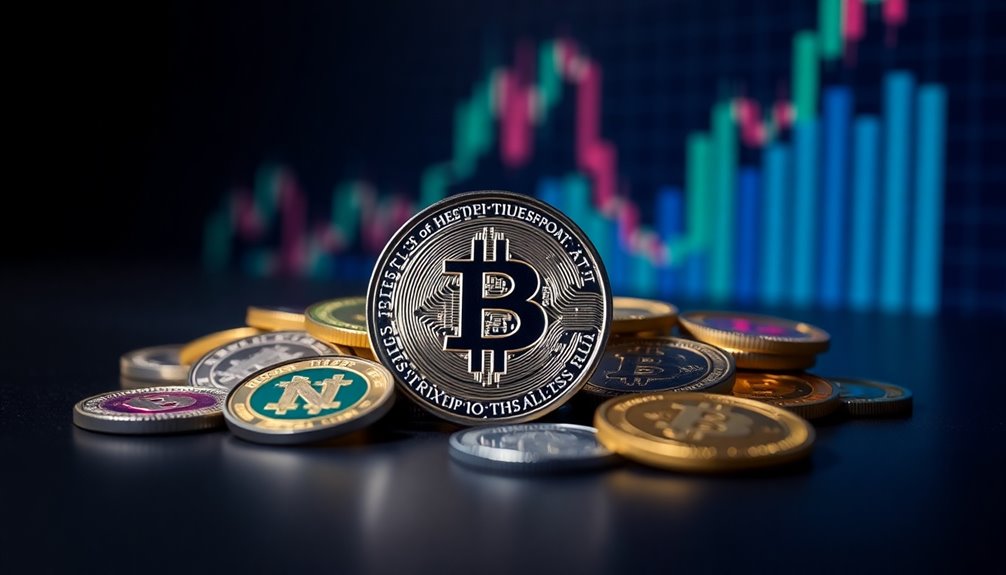The Tron network is a powerful platform that makes stablecoin transfers fast, secure, and affordable. You can enjoy quick transactions thanks to its high throughput and scalability, helping you avoid delays common in other blockchains. Its decentralized governance and security measures guarantee reliable and trustworthy transfers for everyday use. As more people embrace stablecoins, Tron’s infrastructure keeps improving, making it an ideal choice for seamless digital asset transfers—continue exploring to learn more about its capabilities.
Key Takeaways
- Tron Network processes thousands of transactions per second, enabling fast and seamless stablecoin transfers.
- Its scalable infrastructure reduces network congestion, ensuring reliable and cost-effective transactions.
- The decentralized governance system fosters transparency and community-driven improvements for stablecoin support.
- High transaction speed and low fees make Tron ideal for everyday digital asset transfers and remittances.
- Robust security measures protect user assets, maintaining trust and stability in stablecoin transactions on Tron.

The Tron Network is a blockchain platform designed to create a decentralized internet where users can freely publish, store, and own their digital content. As you explore its capabilities, you’ll notice that one of its core strengths lies in addressing cryptocurrency scalability. Unlike traditional blockchains that often struggle with transaction speed and network congestion, Tron offers a high-throughput environment capable of processing thousands of transactions per second. This impressive scalability guarantees that transfers of stablecoins and other digital assets happen swiftly and reliably, making it ideal for everyday use without frustrating delays or exorbitant fees. The network’s architecture is built to handle large volumes of transactions seamlessly, which is essential when dealing with stablecoins that require consistent and quick transfers for users like you.
Another critical feature that sets Tron apart is its decentralized governance. Instead of a central authority controlling the network, Tron employs a system where token holders participate in decision-making processes. This means you have a voice in how the platform evolves, ensuring that changes align with the community’s best interests. Decentralized governance fosters transparency and collective oversight, reducing the risk of single points of failure or manipulation. When it comes to stablecoin transfers, this governance model guarantees that the network remains reliable and resilient, providing a secure environment for your digital assets. You can trust that the platform’s development and updates are driven by the consensus of its community rather than a centralized entity, which enhances overall stability and user confidence.
Furthermore, Tron’s commitment to scalability and decentralized governance directly benefits its ability to facilitate stablecoin transactions. You’ll find that transfers are not only fast but also secure, thanks to the network’s decentralized nature. As stablecoins grow in popularity for everyday transactions, remittances, and decentralized finance (DeFi) applications, Tron’s infrastructure guarantees these transactions are smooth and cost-effective. The combination of high scalability and community-driven governance creates a robust ecosystem where your digital assets are protected, and the network continues to improve with collective input. This makes Tron not just a platform for entertainment or decentralized applications but a reliable backbone for financial transactions, especially stablecoin transfers, where speed, security, and trust are paramount. Additionally, the platform’s security measures are designed to safeguard user assets against potential cyber threats, further enhancing its reliability.
Frequently Asked Questions
How Secure Is the Tron Network for Large Transactions?
You’re likely to find the Tron network fairly secure for large transactions, but you should consider decentralization concerns that could impact overall security. While its high network scalability allows for fast, cost-effective transfers, it may also mean fewer nodes verifying transactions, which can raise security questions. Always make certain you’re using updated security practices and consider network status before conducting significant transactions to minimize risks.
What Are the Transaction Fees on the Tron Network?
Surprisingly, transaction fees on the Tron network are practically nonexistent—so low, you might forget you’re even paying. Thanks to their blockchain scalability and lightning-fast transaction speed, you can send large sums without burning a hole in your wallet. It’s almost like the network’s designed to make transactions seamless and cheap, proving that fast, scalable blockchain tech doesn’t have to come with hefty fees—who knew?
Can Tron Network Handle Cross-Chain Stablecoin Transfers?
Yes, you can handle cross-chain stablecoin transfers on the Tron network. It supports decentralized finance (DeFi) platforms that enable token interoperability, making it easier for you to move stablecoins across different blockchains. Tron’s infrastructure is designed for fast, low-cost transactions, which helps guarantee smooth, secure cross-chain transfers. This makes it a strong choice for managing your stablecoins in a multi-chain environment.
Is the Tron Network Suitable for Enterprise-Level Applications?
You’ll find the Tron network highly suitable for enterprise-level applications because it offers fast transaction speeds, robust network scalability, and strong token adoption. These features enable your business to handle high volumes of transactions efficiently, ensuring smooth operations. By leveraging Tron’s capabilities, you can confidently scale your enterprise, increase token adoption, and benefit from a network built for reliability and growth.
How Does Tron Network Compare to Other Blockchain Platforms?
You’ll find that Tron Network compares favorably to other blockchain platforms because of its decentralized governance, which guarantees community participation in decision-making. Its impressive network scalability allows for high transaction throughput, making it ideal for enterprise applications and stablecoin transfers. While some platforms excel in security or decentralization, Tron strikes a good balance, providing fast, efficient, and scalable solutions for users seeking reliable blockchain performance.
Conclusion
So, as you see, the Tron Network isn’t just a platform—it’s the heartbeat of stablecoin transfers, powering seamless transactions like an unstoppable engine. Imagine riding a wave of efficiency and reliability, where every transfer feels like a smooth sail. With its robust infrastructure, Tron invites you to plunge into a world where your digital assets move effortlessly, making the future of finance brighter and faster—are you ready to ride the wave?









